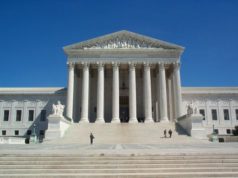
The Supreme Court is an essential part of the United States’ government, charged with the responsibility of interpreting the Constitution and federal laws. Its jurisdiction is wide-reaching and far-reaching, encompassing all cases that involve federal law, the Constitution, and disputes between states. The Supreme Court Clause in the Constitution outlines the scope of the Court’s authority and provides the basis for its impact on American judicial and political systems.
The Supreme Court Clause is found in Article III, Section 2 of the Constitution, which grants the judicial power of the United States to the Supreme Court and to lower federal courts created by Congress. The Clause defines the scope of the Court’s jurisdiction, or its power to hear and decide cases, specifying the categories of cases that the Court can adjudicate. The Clause states that the Supreme Court has “appellate Jurisdiction both as to Law and Fact, with such Exceptions, and under such Regulations as the Congress shall make” and “original jurisdiction in all Cases affecting Ambassadors, other public Ministers and Consuls, and those in which a State shall be a Party.”
The first part of the Supreme Court Clause grants the Court appellate jurisdiction, which means that the Court can hear cases on appeal from lower courts. This jurisdiction applies to both issues of law and issues of fact and is subject to such exceptions and regulations as Congress may make. Appellate jurisdiction allows the Supreme Court to ensure that lower courts follow the law correctly and that the Constitution is upheld correctly.
In matters of appellate jurisdiction, the Supreme Court has the final word in the interpretation of federal law and the Constitution. The Court has the power to declare laws unconstitutional, which means that it can overturn a law that it deems to be in conflict with the Constitution. This power of judicial review, as it is called, is not explicitly granted in the Constitution but was established in the landmark case Marbury v. Madison in 1803. Judicial review is one of the most important powers of the Supreme Court and has shaped the development of American law and politics.
The second part of the Supreme Court Clause grants the Supreme Court original jurisdiction, which means that the Court can hear cases directly and not just on appeal. Original jurisdiction applies to cases involving “Ambassadors, other public Ministers and Consuls” and cases in which “a State shall be a Party.” This provision ensures that the Court has the power to resolve disputes that might arise between states or between the federal government and foreign countries.
Cases that fall under the Court’s original jurisdiction are relatively rare. The vast majority of cases that come before the Supreme Court are appeals from lower courts or writs of certiorari, which is a request for the Supreme Court to review and potentially overturn a decision from a lower court. Nevertheless, the Court’s original jurisdiction is an essential part of its authority and ensures that the Court can act as a neutral arbiter in disputes between states or the federal government and foreign countries.
In addition to its jurisdiction, the Supreme Court has other essential powers and responsibilities outlined in the Constitution. For example, the Court has the power to set its own rules and procedures and to appoint court officers. The Chief Justice of the Supreme Court also has a particular responsibility as the head of the judicial branch and presiding officer over impeachment trials of the President of the United States.
The Supreme Court’s jurisdiction and authority have evolved and expanded over the centuries since its establishment. In the early days of the republic, the Court had a relatively narrow focus, primarily dealing with disputes between states and cases involving commercial law. Still, as the role of the federal government grew, so did the Court’s jurisdiction and the types of cases it heard.
One of the most significant expansions of the Court’s jurisdiction came during the New Deal era of the 1930s. The Court had been hostile to many of President Franklin D. Roosevelt’s program and had struck down many of his economic reform laws. In response, Roosevelt proposed a plan to increase the size of the Court, saying that he wanted “to provide… for retirement at full pay of those judges who reach the age of 70 and who have served for 10 years or more.” Although the plan was seen as a blatant attempt to pack the Court with Roosevelt’s nominees, it ultimately failed. Still, the Court gradually became more receptive to New Deal legislation, and its earlier hostility has come to be seen as an anomaly.
More recently, the Supreme Court has been involved in some of the most contentious political and social issues of the day. Notably, the Court has taken on cases involving same-sex marriage, affirmative action, and abortion rights, among others. These cases have been highly divisive, sometimes pitting the Court’s conservative and liberal justices against one another. Still, regardless of the specific issues at hand, the Court’s role in interpreting the Constitution and federal laws remains paramount.
In conclusion, the Supreme Court’s jurisdiction and authority are vast and far-reaching, encompassing all cases that involve federal law, the Constitution, and disputes between states. The Supreme Court Clause in the Constitution outlines the scope of the Court’s authority and provides the basis for its impact on American judicial and political systems. With the power of judicial review and the ability to establish precedent, the Supreme Court plays a vital role in shaping American laws and policies. Despite the political and social divisions that surround many of its decisions, the Court remains an essential institution in our democratic process.
The Supreme Court of the United States holds Constitutionally-guaranteed powers to exercise its judgment over specific court cases heard in the United States legal system and submitted along the proper channels for the consideration by the Supreme Court. In order to ensure that this privilege is exercised for the good of the United States as a whole, this jurisdictional power is placed under the purview of Congress, which may pass legislation as it sees fit to limit the scope of the cases which may be considered by the Supreme Court of the United States.
The Constitution also provides for certain, albeit limited, cases in which the United States Supreme Court will be automatically discounted from hearing a case. Constitutional and Congressional allocation of judicial jurisdiction is intended both to benefit the ability of the Supreme Court of the United States to fulfill its purpose and to prevent it from usurping the powers granted to the other branches of Government. As to the latter point, the jurisdiction of the United States Supreme Court is oriented toward the protection of the principle of the separation of powers. In terms of the former, however, jurisdiction is simply a tool to ensure that the United States Supreme Court can practically attend to the high volume of court cases heard in the United States every year.
To provide for a realistic workload, the primary power of the Supreme Court of the United States is in appellate form, referring to its ability to hear appeals directed toward findings made in lower cases. This jurisdictional understanding confers both powers and limitations on the Court in the sense that the United States Supreme Court enjoys oversight over lower courts but it cannot, as they do, originate cases, or hold “original jurisdiction”. As an exception to the last rule, the Supreme Court of the United States does have quite limited powers of original jurisdiction. These can be found mostly in cases in which the representatives of other governments, such as ambassadors, are involved, and in lawsuits brought by one American State against another.
Conversely, there is placed a limit on the jurisdiction of the United States Supreme Court, newly considered to exclude lawsuits brought against an American State by residents of another State or country, though some limitations can be observed on this restriction. Based on its Constitutional power to regulate the jurisdiction of the Supreme Court of the United States, Congress has passed legislation excluding from the Court’s consideration any lawsuits between residents of individual states with less than $75,000 at stake. In recent history, the Congressional ability to limit the jurisdiction of the United States Supreme Court proved a source of controversy when Congress passed legislation excluding from consideration by the Court cases brought by certain kinds of prisoners of war. The George W. Bush Administration sponsored this Bill to protect its policy of placing suspected terrorists in detention in the U.S. military base at Guantanamo Bay, where the defendants’ habeas appeals were blocked from being heard by the Detainee Treatment Act.


























